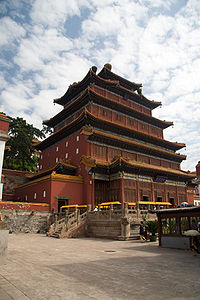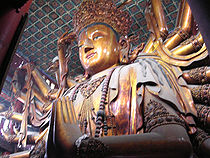
Puning Temple
Encyclopedia

Chengde
Chengde , previously known as Jehol or Re He , is a prefecture-level city in Hebei province, People's Republic of China, situated northeast of Beijing. It is best known as the site of the Mountain Resort, a vast imperial garden and palace formerly used by the Qing emperors as summer residence...
, Hebei
Hebei
' is a province of the People's Republic of China in the North China region. Its one-character abbreviation is "" , named after Ji Province, a Han Dynasty province that included what is now southern Hebei...
province, China
China
Chinese civilization may refer to:* China for more general discussion of the country.* Chinese culture* Greater China, the transnational community of ethnic Chinese.* History of China* Sinosphere, the area historically affected by Chinese culture...
(commonly called the Big Buddha Temple) is a Qing Dynasty
Qing Dynasty
The Qing Dynasty was the last dynasty of China, ruling from 1644 to 1912 with a brief, abortive restoration in 1917. It was preceded by the Ming Dynasty and followed by the Republic of China....
era Buddhist temple complex built in 1755, during the reign of the Qianlong Emperor
Qianlong Emperor
The Qianlong Emperor was the sixth emperor of the Manchu-led Qing Dynasty, and the fourth Qing emperor to rule over China proper. The fourth son of the Yongzheng Emperor, he reigned officially from 11 October 1735 to 8 February 1796...
(1735-1796 AD) to show the Qing's respect to the ethnic minorities. It is located near the Chengde Mountain Resort, and alongside the equally famed Putuo Zongcheng Temple
Putuo Zongcheng Temple
The Putuo Zongcheng Temple of Chengde, Hebei province, China is a Qing Dynasty era Buddhist temple complex built between 1767 and 1771, during the reign of the Qianlong Emperor . It is located near the Chengde Mountain Resort, which is south of the Putuo Zongcheng. Along with the equally famed...
, it is one of the "Eight Outer Temples" of Chengde. Much how the Putuo Zongcheng Temple was modeled after the Tibet
Tibet
Tibet is a plateau region in Asia, north-east of the Himalayas. It is the traditional homeland of the Tibetan people as well as some other ethnic groups such as Monpas, Qiang, and Lhobas, and is now also inhabited by considerable numbers of Han and Hui people...
an Potala Palace
Potala Palace
The Potala Palace is located in Lhasa, Tibet Autonomous Region, China. It was named after Mount Potala, the abode of Chenresig or Avalokitesvara...
, the Puning Temple was modeled after the Samye Monastery, the sacred Lamaist site in Tibet. The front temple was constructed in the Chinese style, although the temple complex follows both Chinese and Tibetan architectural styles. The Puning Temple also houses the world's tallest wooden sculpture of the Bodhisattva
Bodhisattva
In Buddhism, a bodhisattva is either an enlightened existence or an enlightenment-being or, given the variant Sanskrit spelling satva rather than sattva, "heroic-minded one for enlightenment ." The Pali term has sometimes been translated as "wisdom-being," although in modern publications, and...
Avalokiteśvara
Avalokitesvara
Avalokiteśvara is a bodhisattva who embodies the compassion of all Buddhas. He is one of the more widely revered bodhisattvas in mainstream Mahayana Buddhism....
(22.28-meter-high and 110-ton), hence the Puning Temple is often nicknamed the "Big Buddha Temple". The complex features temple halls, pavilions, drum towers and bell towers.
History


Ming Dynasty
The Ming Dynasty, also Empire of the Great Ming, was the ruling dynasty of China from 1368 to 1644, following the collapse of the Mongol-led Yuan Dynasty. The Ming, "one of the greatest eras of orderly government and social stability in human history", was the last dynasty in China ruled by ethnic...
, the Dzungar people of northwestern China (modern Xinjiang
Xinjiang
Xinjiang is an autonomous region of the People's Republic of China. It is the largest Chinese administrative division and spans over 1.6 million km2...
) were engaged in a civil war and conflicts with other nomad
Nomad
Nomadic people , commonly known as itinerants in modern-day contexts, are communities of people who move from one place to another, rather than settling permanently in one location. There are an estimated 30-40 million nomads in the world. Many cultures have traditionally been nomadic, but...
ic horse-archer groups in the region. The later Qianlong Emperor dispatched an army to Yili
Yili
Yili may refer to:*Yili , Chinese classic text*Yili Group, company of dairy industry in China*Yili horse, small horse from the north-western Xinjiang region of China*Ili Kazakh Autonomous Prefecture, in northernmost Xinjiang, China...
in order to suppress their resistance against the Qing Dynasty. The Chinese attacked Kulja (Yining) and captured the ruling Dzungar khan
Khan (title)
Khan is an originally Altaic and subsequently Central Asian title for a sovereign or military ruler, widely used by medieval nomadic Turko-Mongol tribes living to the north of China. 'Khan' is also seen as a title in the Xianbei confederation for their chief between 283 and 289...
. After the conquest, Emperor Qianlong personally inscribed his writing on a tablet that is located in the stele pavilion of the Puning Temple. This stele of 1755, called the Puning Sibei, commemorated the founding of the temple and the conquering of the Dzungars. Qianlong ordered for the building of this new Temple of Universal Peace, a symbol of the emperor's ambition to maintain peace among various ethnic minorities and a stable environment within the northwestern regions. The historian Waley-Cohen calls Chengde "a crucial location for the exhibition of Manchu power and the representation of Qing imperial knowledge," being the location of the summer capital. Since the Dzungar were followers of Lamaism, the temple was built in imitation of Samye monastery, the sacred place of Lamaism in Tibet.
The large wooden Buddhist statue of the Bodhisattva Avalokiteśvara
Avalokitesvara
Avalokiteśvara is a bodhisattva who embodies the compassion of all Buddhas. He is one of the more widely revered bodhisattvas in mainstream Mahayana Buddhism....
within the main hall of the Puning Temple is one of its most renowned features. It shows a thousand different eyes and a thousand different arms stretched out from its frame (in various sizes). The statue itself is made from five kinds of wood, including pine
Pine
Pines are trees in the genus Pinus ,in the family Pinaceae. They make up the monotypic subfamily Pinoideae. There are about 115 species of pine, although different authorities accept between 105 and 125 species.-Etymology:...
, cypress
Cypress
Cypress is the name applied to many plants in the cypress family Cupressaceae, which is a conifer of northern temperate regions. Most cypress species are trees, while a few are shrubs...
, elm
Elm
Elms are deciduous and semi-deciduous trees comprising the genus Ulmus in the plant family Ulmaceae. The dozens of species are found in temperate and tropical-montane regions of North America and Eurasia, ranging southward into Indonesia. Elms are components of many kinds of natural forests...
, fir
Fir
Firs are a genus of 48–55 species of evergreen conifers in the family Pinaceae. They are found through much of North and Central America, Europe, Asia, and North Africa, occurring in mountains over most of the range...
, and linden
Tilia
Tilia is a genus of about 30 species of trees native throughout most of the temperate Northern Hemisphere. The greatest species diversity is found in Asia, and the genus also occurs in Europe and eastern North America, but not western North America...
.
As of 1994, the Chengde Mountain Resort and Chengde's Eight Outer Temples (including the Puning Temple) were established as UNESCO
UNESCO
The United Nations Educational, Scientific and Cultural Organization is a specialized agency of the United Nations...
World Heritage Sites. Today, the Puning Temple remains a site of tourist attraction and local festivities.
External links
- Eight Outer Temples, Puning Temple
- Chengde Travel Guide
- Tour of Chengde, Eight Outer Temples
- World Heritage Panographic Tour, 360 degree view within the temple from the third balcony, front view of the Bodhisattva statue
- World Heritage Tour, 360 degree view on the ground floor of the temple, viewing the Bodhisattva statue from the bottom
- World Heritage Panographic Tour, 360 degree view outside the main temple

